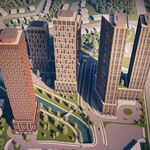From the Star:
Teardown an 8-year project
A proposal to tear down part of the Gardiner Expressway will kill plans to extend Front St., Toronto's deputy mayor said this morning.
May 30, 2008 06:51 PM
Deena Kamel
Staff Reporter
It will take up to eight years and approximately $ 200-300 million to tear down the East Gardiner Expressway from Jarvis St. to the DVP, including up to five years to conduct an environmental assessment of the project, Waterfront Toronto announced today in a press conference.
On June 12, the Waterfront Toronto board will make a recommendation supporting the East Gardiner tear-down through an individual environmental assessment that will analyze and clarify the technical issues and impacts, Waterfront Toronto Chair Mark Wilson said.
It will also recommend the re-allocation of funds from the Front St. extension to the improvement of the waterfront.
City council will discuss the proposal on July 14 and 15.
Tearing down the eastern stretch of the Gardiner will allow the development of surrounding communities, create high-quality urban design and support new transit initiatives, Wilson said.
The impact on traffic and travel time includes an added 2 minutes from Queen and Woodbine to King and Bay during the morning peak hours and a reduction in travel speed by 12.5 percent, Wilson said. The east end of the Gardiner is the least congested part of the expressway. Repairs cost the city about $6-10 million annually, according to Waterfront Toronto statistics.
"This decision is a decision about the future vision for the city. We need a vision that embraces and leads the global changes we're a part of, not one that tries to preserve patterns and habits of the past," Wilson said. "Taking down the Gardiner is a bold step and a declaration that Toronto is ready to be part of that future."
Waterfront Toronto CEO John Campbell described the project as "realistic and doable now."
Early proposals had raised the idea of tearing down the Gardiner from Spadina Ave.
“We just don't have the funds,” Campbell said of that idea. “It's too big a bite."
Long-serving former Metro Toronto roads and traffic commissioner Sam Cass disagrees with the plan.
"It doesn't make any sense. It never has,” he said. “Talking about (the expressway) some sort of physical or visual obstruction doesn't either," Cass said.
He argued that the Gardiner does not block access from Front St to Lakeshore Blvd. He asked planners to show him the precise point of blockage and he was pointed to one ramp near Church St. Cass said, adding that it was not in front of any vehicle or pedestrian crossing.
"Talking about obstruction is stupid, because it doesn’t. I've looked up and down and I have asked many planners to show where it obstructs. With all the new condominiums there you can hardly find it." Cass exclaimed. "They had trouble finding it because of all the condos." He added that the condos are solid constructions, whereas the Gardiner was elevated above the travelled part of the road.
Architect Calvin Brook of Brook McIlroy Inc., who studied the issue of transforming the Gardiner in 2003, explained that demolishing the eastern section makes sense because the elevated Gardiner is replaced with an elevated road and that the absence of the expressway would result in "spectacular property," which is "logical from a real estate perspective."
However, tearing down the section between Spadina Ave. and Jarvis St. "won’t work." Brook said, adding that it defeats the purpose to create a better connection to the waterfront. He pointed that a 12-lane highway would create "hostile traffic" to pedestrians and "frustrated drivers." Brook added that the Gardiner was "not maintained properly" and "not treated as civic architecture."
The solution, he believes, is to transform the Gardiner through better lighting and utilize the space of open dirt under it through landscape planting, setting up flea markets, and skateboard parks.
The Canadian Automobile Association opposes the demolition. The 12-lane highway, different from expressway-style traffic, would also lead to further congestion, driver frustration, safety concerns, and pollution, said spokesperson Faye Lyons.
http://www.thestar.com/News/article/434236
___
He argued that the Gardiner does not block access from Front St to Lakeshore Blvd. He asked planners to show him the precise point of blockage and he was pointed to one ramp near Church St. Cass said, adding that it was not in front of any vehicle or pedestrian crossing.
"Talking about obstruction is stupid, because it doesn’t. I've looked up and down and I have asked many planners to show where it obstructs. With all the new condominiums there you can hardly find it." Cass exclaimed. "They had trouble finding it because of all the condos." He added that the condos are solid constructions, whereas the Gardiner was elevated above the travelled part of the road.
Cass should perhaps stick to engineering and avoid the area of urban design. In case he want to do otherwise, perhaps he should acquaint himself with some VERY early work by Kevin Lynch on "edges". Try walking along the Gardiner side of the various condos and there isn't any barrier effect at work? Right.
Then again, from the sound of it, his definition of "barrier" meaning being able physically pass through something - you can have a space just wide enough for a one-person to pass through and it still won't be a barrier.
AoD




